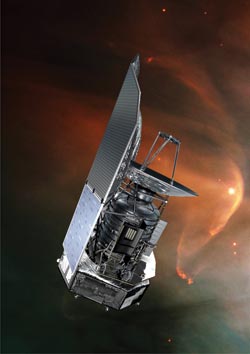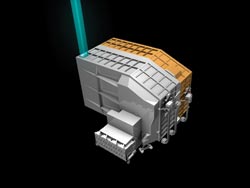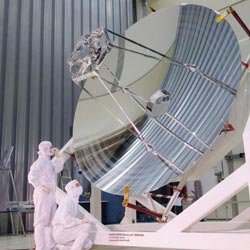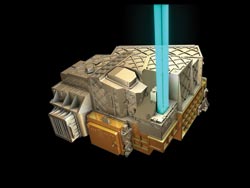The Herschel space telescope soon will be heading toward its new home at the L2 Lagrange point to capture images and spectrographic information about the universe’s earliest stars and galaxies.

Artist’s rendition of the Herschel space telescope at the L2 Lagrange point between the Earth and sun. Courtesy of European Space Agency. Image by D. Ducros.
With a 3.5-m primary mirror, the telescope will have the largest such reflector to date among the space telescopes, besting the Hubble’s 2.5-m primary.
Operated by the European Space Agency, the Herschel was scheduled for launch at press time along with the Planck satellite, which is destined to seek cosmic background radiation from a different orbit. With its superior light-collecting ability and three main instrument packages, the Herschel will scan deep-space objects in the 60- to 670-μm range, providing information on galactic formation in the early universe, on stellar creation activity and on the chemical composition of extrasolar planetary atmospheres and surfaces.

SPIRE (Spectral and Photometric Imaging REceiver) is a colour camera and imaging spectrometer that captures wavelengths from 194 to 672 μm and records photometric data at three bands – 250, 350 and 500 μm – simultaneously. Image by C. Carreau. Courtesy of European Space Agency.
The instruments carried by the Herschel are SPIRE (Spectral and Photometric Imaging REceiver), PACS (Photodetector Array Camera and Spectrometer) and HIFI (Heterodyne Instrument for the Far Infrared).

The Herschel space telescope has a 3.5-m-diameter primary mirror that is protected by a sunshade. The mirror focuses incoming light onto three scientific instruments housed in a cryostat that keeps the instruments at less than –171 °C. Courtesy of European Space Agency.
The main contractor for the telescope is Thales Alenia Space Industries of Cannes, France, which leads a consortium of industrial partners that includes Thales Alenia Space of Torino, Italy, and Astrium GmbH of Friedrichshafen, Germany.

Herschel’s PACS (Photodetector Array Camera and Spectrometer) instrument comprises a colour camera and an imaging spectrometer that capture wavelengths between 55 and 210 μm. Image by C. Carreau. Courtesy of European Space Agency.